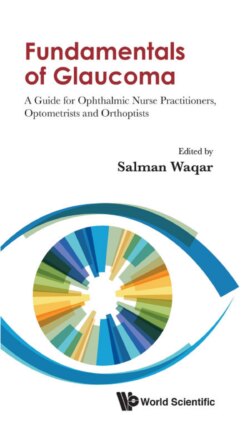Читать книгу Fundamentals Of Glaucoma: A Guide For Ophthalmic Nurse Practitioners, Optometrists And Orthoptists - Группа авторов - Страница 15
На сайте Литреса книга снята с продажи.
Primary Angle Closure
ОглавлениеPrimary angle closure glaucoma is due to the iridocorneal angle (and therefore trabecular meshwork) being occluded by the iris. Primary angle closure is more common in hyperopic persons, because the iridocorneal angle is more acute at baseline.
The clinical presentation of the patient with primary angle closure glaucoma is either acute with severe symptoms or chronic, which may be asymptomatic.
The chief symptom of acute primary angle closure is an extremely painful red eye, which is due to raised pressure within the eye (usually in the range of 50–100 mmHg). Due to the severity of the symptoms, patients often present to the A&E Department and initially diagnoses of subarachnoid haemorrhage or cluster headache are often considered.
Characteristic clinical signs are a deeply injected eye and opaque cornea. The cornea is often oedematous due to the corneal endothelial pumps being overwhelmed by the significant hydrostatic pressure from the anterior chamber. The iris is fixed and usually mid-dilated due to a combination of ischemia and inflammatory reaction. There is an inflammatory component due to the ischaemic damage to the iris causing breakdown of the blood-aqueous barrier. This inflammation can cause adhesions between the iris and lens (posterior synechiae) or between the iris and cornea (peripheral anterior synechiae).
Breaking this attack medically is the first stage in management, which should be followed by laser iridotomy and/or surgical lens extraction and intraocular lens insertion, which will be covered in more detail in later chapters.
There may be chronic angle closure where the pressure within the eye has been raised for many months or years due to partial occlusion of the trabeculum. This is usually asymptomatic. Definitive management is lens extraction to make more space within the anterior chamber.
It is possible to have narrow iridocorneal angles without raised pressure and without signs of glaucoma. The risk of developing high pressure with this anatomical configuration is significant, and prophylactic laser peripheral iridotomies are often performed if there is greater than 180° of Shaeffer Grade 1 or 0 on the gonioscopy.
In plateau iris syndrome, anteriorly rotated ciliary body processes can push the peripheral iris forward thereby causing narrowing of the iridocorneal angle.
